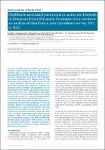Healthcare-associated pneumonia in acute care hospitals in European Union/European Economic Area countries: an analysis of data from a point prevalence survey, 2011 to 2012
Walter, Jan
Haller, Sebastian
Quinten, Chantal
Kärki, Tommi
Zacher, Benedikt
Eckmanns, Tim
Abu Sin, Muna
Plachouras, Diamantis
Kinross, Pete
Suetens, Carl
An aim of the ECDC point prevalence survey (PPS) in European Union/European Economic Area acute care hospitals was to acquire standardised healthcare-associated infections (HAI) data. We analysed one of the most common HAIs in the ECDC PPS, healthcare-associated pneumonia (HAP). Standardised HAI case definitions were provided and countries were advised to recruit nationally representative subsets of hospitals. We calculated 95% confidence intervals (CIs) around prevalence estimates and adjusted for clustering at hospital level. Of 231,459 patients in the survey, 2,902 (1.3%; 95% CI: 1.2–1.3) fulfilled the case definition for a HAP. HAPs were most frequent in intensive care units (8.1%; 95% CI: 7.4–8.9) and among patients intubated on the day of the survey (15%; 95% CI: 14–17; n = 737 with HAP). The most frequently reported microorganism was Pseudomonas aeruginosa (17% of 1,403 isolates), followed by Staphylococcus aureus (12%) and Klebsiella spp. (12%). Antimicrobial resistance was common among isolated microorganisms. The most frequently prescribed antimicrobial group was penicillins, including combinations with beta-lactamase inhibitors. HAPs occur regularly among intubated and non-intubated patients, with marked differences between medical specialities. HAPs remain a priority for preventive interventions, including surveillance. Our data provide a reference for future prevalence of HAPs at various settings.
Dateien zu dieser Publikation

